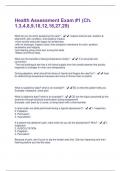Health Assessment Exam #1 (Ch.
1,3,4,8,9,10,12,18,27,29)
What do you do when assessing the ears? - ✔️✔️-inspect external ear: position &
alignment, skin condition, and auditory meatus
-move auricle and push tragus for tenderness
-with an otoscope, inspect canal, then tympanic membrane for color, position,
landmarks and integrity
-test hearing using voice test; tuning fork tests
-Weber and Rinne tests
What are the benefits of taking temperature orally? - ✔️✔️-It is accurate and
convenient
-The oral sublingual site has a rich blood supply from the carotid arteries that quickly
responds to changes in inner core temperature
During palpation, what should the dorsa of hands and fingers be used for? - ✔️✔️-best
for determining temperature because skin here is thinner than on palms
What is subjective data? what is an example? - ✔️✔️SD is what the patient tells you
Example: headache, chest pain
What is objective data? what is an example? - ✔️✔️OD are the signs perceived by the
examiner through physical examination during assessment
Example: rash seen by a nurse, or temp taken with a thermometer
In what order are skills performed during a typical assessment? - ✔️✔️1. Inspection
2. Palpation
3. Percussion
4. Auscultation
If a patient has abdomen pain, what order do you do the assessment? Why? - ✔️✔️1.
Inspection
2. AUSCULTATION
3. Palpation
4. Percussion
Because of pain, don't touch or tap the tender area first. Start by inspecting and then
listening before you feel the area.
,What occurs during palpation, the second step? - ✔️✔️Palpation applies sense of
touch to assess
Can include:
temperature, texture, moisture, organ location and size, swelling, vibration or pulsation,
rigidity or spasticity, crepitation, presence of lumps or masses, presence of tenderness
or pain
-use fingers unless taking temperature
How can you assess factors during the palpation step? - ✔️✔️by using different parts
of the hands
What does the health history provide? - ✔️✔️Subjective and objective data
During palpation, what should fingertips be used to feel? - ✔️✔️-best for fine tactile
discrimination of skin texture, swelling, pulsation, and determining presence of lumps
During palpation, what should fingers and thumb be used for? - ✔️✔️-detection of
position, shape, and consistency of an organ or mass
During palpation, what should the base of fingers or the ulnar surface of hand be used
for? - ✔️✔️-best for vibration
**-vibrations are felt on the ulnar side of hand
During palpation, what type of palpation should you start with and why? What steps are
next? - ✔️✔️1. start with LIGHT palpation to detect surface characteristics and
accustom person to being touched
-1 cm
2. then deeper palpations when needed
-intermittent pressure better than one long continuous palpation
-5 to 8 cm or 2-3 in
ALSO: bimanual palpation- requires use of both hands to envelop or capture certain
body parts or organs such as kidneys, uterus or adnexa for precise delimitation
What occurs during percussion, the third step? - ✔️✔️-consists of tapping a person's
skin with short, sharp strokes to assess underlying structures
What uses does percussion have? - ✔️✔️-mapping location and size of organs
-signaling density of a structure by a characteristic note
-detecting a superficial abnormal mass
1. percussion vibrations penetrate about 5 cm
, deep
2. deeper mass would give no change in percussion
-eliciting pain if underlying structure is inflamed
-eliciting deep tendon reflex using percussion hammer
HOLLOW (AIR-FILLED) ORGANS SOUND DIFFERENT THAN SOLID ORGANS -
✔️✔️
What are the two methods of percussion? - ✔️✔️1. Direct, or immediate, which is when
the striking hand directly contacts body wall
2. Indirect, or mediate, is when you use both hands and the striking hand contacts
stationary hand fixed on person's skin
In regards to percussion, what is resonance and where does it occur? -
✔️✔️Resonance is low pitch and it occurs over normal lungs
What occurs during inspection, the first step? - ✔️✔️-ALWAYS COMES FIRST
-begins when you first meet a person w/ a general survey
-you should start assessment of each body system with inspection
-requires: good lighting, adequate exposure, use of instruments including otoscope,
opthalmoscope, penlight, or specula
In regards to percussion, what is hyperresonant and where does it occur? -
✔️✔️Hyperresonant is lower pitch and it occurs over child's lungs
In regards to percussion, what is tympany and where does it occur? - ✔️✔️Tympany is
high pitch and it occurs over air filled organs (stomach, intestines)
In regards to percussion, what is dull and where does it occur? - ✔️✔️Dull is high pitch
and it occurs over solid organs (liver, spleen)
In regards to percussion, what is flat and where does it occur? - ✔️✔️Flat is high pitch
and it occurs where no air is present such as over muscles/bones or a tumor
What occurs during auscultation, the fourth step? - ✔️✔️Auscultation is when you listen
to sounds produced by the body
-most sounds are soft and must be channeled through a stethoscope
-once you can recognize normal sounds, you can distinguish the abnormal sounds and
"extra" or abnormal sounds
What is the single most important step in decreasing microorganism transmission? -
✔️✔️WASH YOUR HANDS
-before physical contact with each patient
-after inadvertent contact with blood, body fluids, secretions, and excretions
-after contact with any equipment contaminated with body fluids




